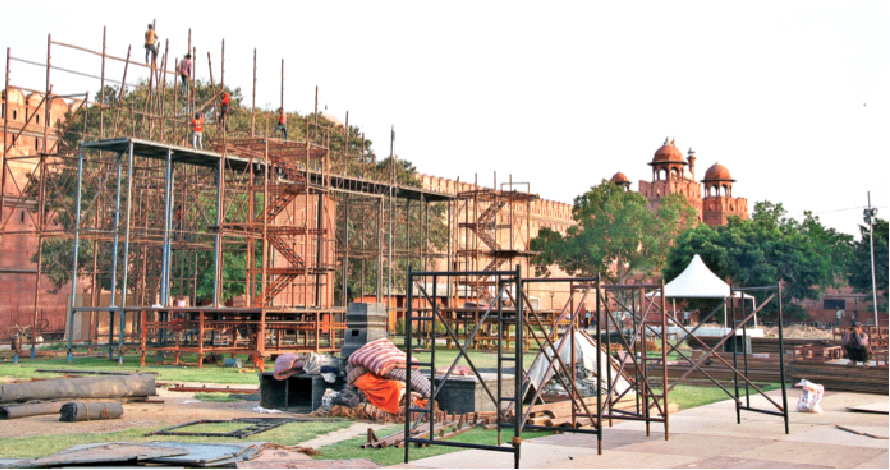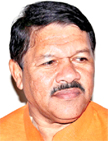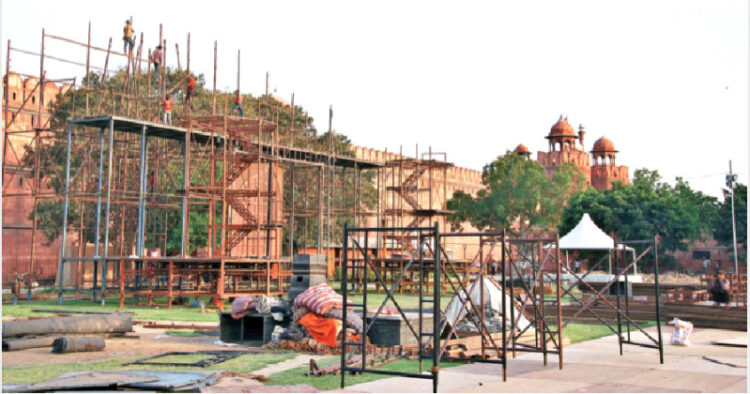 For the first time Shivajij to come alive through mega play ‘Raja Shivchhatrapati: Aitihasik Gauravgatha’ in Hindi at Red Fort from April 6 to 10
For the first time Shivajij to come alive through mega play ‘Raja Shivchhatrapati: Aitihasik Gauravgatha’ in Hindi at Red Fort from April 6 to 10
Pramod Kumar
Do you know Rabindranath Tagore wrote two poems, ‘Pratinidhi’ and ‘Shibaji Utsav’ that dwell more on the character of Shivaji and his relevance to the contemporary Bharat rather than mere descriptions of events in the great ruler’s life? Similarly, Lala Lajpat Rai wrote a biography of the great ruler in 1896 in Urdu, which was published from Lahore. Why did these great freedom fighters write on Shivaji? It was because they realised that Shivaji had inspired the entire nation. Today, people in whole country may know Shivaji, but there are very few who have really studied the contribution of this great warrior and administrator or experienced his life and works through any play, etc. The people in Maharashtra are well aware of him because of the various plays staged there regularly, but the people in northern India, especially the young generation in Hindi belt, do not know much about Shivaji’s contribution to the freedom struggle.
|
The distortions in history textbooks have also been one of the hindrances that prevented people from knowing about this great warrior.
 “The mega play has been prepared in Hindi so that maximum number of people can experience the glorious era of Bharat. Not only the students and professionals, people from all segments of the society are being contacted to ensure their presence” — Shyam Jaju, convener, Raja Shivchhatrapati Mahanatya Aayojan Samiti”
“The mega play has been prepared in Hindi so that maximum number of people can experience the glorious era of Bharat. Not only the students and professionals, people from all segments of the society are being contacted to ensure their presence” — Shyam Jaju, convener, Raja Shivchhatrapati Mahanatya Aayojan Samiti”In order to apprise the countrymen with the glorious history of Bharat, particularly related to Chhatrapati Shivaji, the leading Marathi writer Shivshahir Babasaheb Purandare wrote Shivaji’s biography, Janata Raja, and later converted it into a play in Marathi. This mega play is considered to be Asia’s biggest and world’s second biggest drama. An imposing stage, live music, about 250 artists, elephants and horses transport the audience majestically into Shivaji’s era. It teaches the importance of Rashtra Dharma and makes one realise the duty towards the society. So far, more than 1200 shows of this play have been organised in India, the US, England and other countries. It is the story of a Hindu king who conceived the idea of ‘Hindavi Swarajya’, the Hindu model of self-governance.
Interview/ Baba Saheb Purandare : “Shivaji is a Three-Letter Mantra
With the objective of connecting people of Delhi with this great saga of bravery, good governance, administrative acumen, intelligence network, zero tolerance towards corruption, justice and technical know-how during that era, the Hindi version of ‘Janata Raja’ is being staged at Red Fort from April 6 to 10. Titled as “Raja Shivchhatrapati: Aitihasik Gauravgatha” it will be first mega show in Hindi. Prior to the show, there will be a brief appearance of some great personality including Prime Minister of India Shri Narendra Modi, everyday.
The marvellous stage will have different music instruments giving realistic touch to the wars fought by Shivaji. “The play is also an endeavour to connect the people of Delhi with some of the incidents that took place in Delhi in those days. It was at Buradi Ghat (today’s North Delhi) that Dattaji Shinde was killed in a battle with Afghan Najib Khan in 1760, while defending Delhi. The wounded Dattaji was asked by Najib Khan: “Kyun Patil aur bhi ladoge?”, to which the great Maratha replied, “Bachenge toh aur bhi ladenge.” This became a great inspiration for Maratha soldiers even after Dattaji was slain. Similarly, it was in March 1737 that the Maratha and Mughal armies, each numbering around 8,000, clashed at Rakabganj, near the present Parliament House, when over 400 Mughal soldiers were killed, and an equal number wounded; prompting the Mughal contingent to beat a hasty retreat to the safety of the Red Fort. In 1788, Mahadji Scindia had hoisted the swallow-tailed saffron flag on the Red Fort, making Maratha control of the city almost absolute,” says Shri Pramod Mujumdar, one of the organisers.
To make the event a big hit, Shri Dharmik Ramlila Committee, which organises Ramlila at the Red Fort every year, and many other organisations of Delhi have been involved in preparations and management. However, the main force behind the event is Delhi Marathi Pratisthan, while the play is being staged under the banner of Raja Shivchhatrapati Mahanatya Aayojan Samiti. “The preparations for the play are in full swing at Madhav Park outside Red Fort facing Chadani Chowk. Different teams are working tirelessly to ensure that more Delhiites watch the play. Entry is free, but online registration is mandatory through an online link ‘Book my Show’. Adequate arrangements have been made for generating awareness through Metro coaches, Metro Stations, bus stands, roadside hoardings, universities, market places, etc. Apart from it, variety of digital content has been prepared in the form of videos, WhatsApp messages. Special interactions are being organised with professionals like advocates, doctors, CAs, professors, etc and students in colleges and universities,” said Shri Shyam Jaju, convener of the organising committee.
“The original idea of staging the play in Hindi was conceived by former Union Minister the late Anil Madhav Dave. But it could not be materialised as he passed away last year. Dr Sachidanand Joshi, Member Secretary of Indira Gandhi National Centre for the Art has played a significant role in materialising the idea now. Baba Saheb Purandare also called on Prime Minister Shri Narendra Modi on August 22, 2017 and the PM appreciated the idea,” adds Shri Mujumdar.
The play is an immersive experience where one finds oneself living in a glorious era. The recreation of real life ambience with horses, elephants, camels, bullock carts and palanquin taking to the stage and taking the viewer on a sojourn from King Shivaji’s birth to his becoming a proclaimed King is really thrilling. A must watch, if one wishes to know the glorious history of Bharat.













Comments